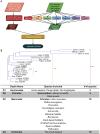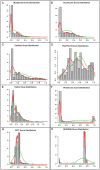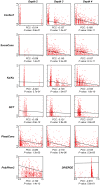Relating the disease mutation spectrum to the evolution of the cystic fibrosis transmembrane conductance regulator (CFTR)
- PMID: 22879944
- PMCID: PMC3413703
- DOI: 10.1371/journal.pone.0042336
Relating the disease mutation spectrum to the evolution of the cystic fibrosis transmembrane conductance regulator (CFTR)
Abstract
Cystic fibrosis (CF) is the most common genetic disease among Caucasians, and accordingly the cystic fibrosis transmembrane conductance regulator (CFTR) protein has perhaps the best characterized disease mutation spectrum with more than 1,500 causative mutations having been identified. In this study, we took advantage of that wealth of mutational information in an effort to relate site-specific evolutionary parameters with the propensity and severity of CFTR disease-causing mutations. To do this, we devised a scoring scheme for known CFTR disease-causing mutations based on the Grantham amino acid chemical difference matrix. CFTR site-specific evolutionary constraint values were then computed for seven different evolutionary metrics across a range of increasing evolutionary depths. The CFTR mutational scores and the various site-specific evolutionary constraint values were compared in order to evaluate which evolutionary measures best reflect the disease-causing mutation spectrum. Site-specific evolutionary constraint values from the widely used comparative method PolyPhen2 show the best correlation with the CFTR mutation score spectrum, whereas more straightforward conservation based measures (ConSurf and ScoreCons) show the greatest ability to predict individual CFTR disease-causing mutations. While far greater than could be expected by chance alone, the fraction of the variability in mutation scores explained by the PolyPhen2 metric (3.6%), along with the best set of paired sensitivity (58%) and specificity (60%) values for the prediction of disease-causing residues, were marginal. These data indicate that evolutionary constraint levels are informative but far from determinant with respect to disease-causing mutations in CFTR. Nevertheless, this work shows that, when combined with additional lines of evidence, information on site-specific evolutionary conservation can and should be used to guide site-directed mutagenesis experiments by more narrowly defining the set of target residues, resulting in a potential savings of both time and money.
Conflict of interest statement
Figures







Similar articles
-
Disease-relevant mutations alter amino acid co-evolution networks in the second nucleotide binding domain of CFTR.PLoS One. 2020 Jan 24;15(1):e0227668. doi: 10.1371/journal.pone.0227668. eCollection 2020. PLoS One. 2020. PMID: 31978131 Free PMC article.
-
Structural mechanisms for defective CFTR gating caused by the Q1412X mutation, a severe Class VI pathogenic mutation in cystic fibrosis.J Physiol. 2019 Jan;597(2):543-560. doi: 10.1113/JP277042. Epub 2018 Dec 2. J Physiol. 2019. PMID: 30408177 Free PMC article.
-
Optimization of the degenerated interfacial ATP binding site improves the function of disease-related mutant cystic fibrosis transmembrane conductance regulator (CFTR) channels.J Biol Chem. 2010 Nov 26;285(48):37663-71. doi: 10.1074/jbc.M110.172817. Epub 2010 Sep 22. J Biol Chem. 2010. PMID: 20861014 Free PMC article.
-
Clinical implications of cystic fibrosis transmembrane conductance regulator mutations.Clin Chest Med. 1998 Sep;19(3):443-58, v. doi: 10.1016/s0272-5231(05)70092-7. Clin Chest Med. 1998. PMID: 9759548 Review.
-
Cystic fibrosis: a worldwide analysis of CFTR mutations--correlation with incidence data and application to screening.Hum Mutat. 2002 Jun;19(6):575-606. doi: 10.1002/humu.10041. Hum Mutat. 2002. PMID: 12007216 Review.
Cited by
-
In silico analysis for determining the deleterious nonsynonymous single nucleotide polymorphisms of BRCA genes.Mol Biol Res Commun. 2019 Dec;8(4):141-150. doi: 10.22099/mbrc.2019.34198.1420. Mol Biol Res Commun. 2019. PMID: 32042831 Free PMC article.
-
Curated multiple sequence alignment for the Adenomatous Polyposis Coli (APC) gene and accuracy of in silico pathogenicity predictions.PLoS One. 2020 Aug 4;15(8):e0233673. doi: 10.1371/journal.pone.0233673. eCollection 2020. PLoS One. 2020. PMID: 32750050 Free PMC article.
-
Stability Prediction for Mutations in the Cytosolic Domains of Cystic Fibrosis Transmembrane Conductance Regulator.J Chem Inf Model. 2021 Apr 26;61(4):1762-1777. doi: 10.1021/acs.jcim.0c01207. Epub 2021 Mar 15. J Chem Inf Model. 2021. PMID: 33720715 Free PMC article.
-
Longevity and plasticity of CFTR provide an argument for noncanonical SNP organization in hominid DNA.PLoS One. 2014 Oct 28;9(10):e109186. doi: 10.1371/journal.pone.0109186. eCollection 2014. PLoS One. 2014. PMID: 25350658 Free PMC article.
-
Evolution- and structure-based computational strategy reveals the impact of deleterious missense mutations on MODY 2 (maturity-onset diabetes of the young, type 2).Theranostics. 2014 Jan 29;4(4):366-85. doi: 10.7150/thno.7473. eCollection 2014. Theranostics. 2014. PMID: 24578721 Free PMC article.
References
-
- Riordan JR, Rommens JM, Kerem B, Alon N, Rozmahel R, et al. (1989) Identification of the cystic fibrosis gene: cloning and characterization of complementary DNA. Science 245: 1066–1073. - PubMed
-
- Zieve D, Hadjiliadis D (2011) Cystic Fibrosis. Available: http://www.ncbi.nlm.nih.gov/pubmedhealth/PMH0001167/. Accessed 2012 Mar 30..
Publication types
MeSH terms
Substances
Grants and funding
LinkOut - more resources
Full Text Sources
Medical

